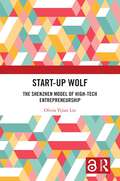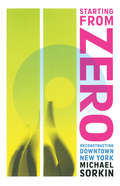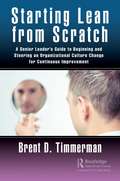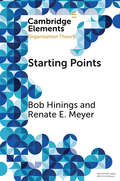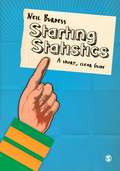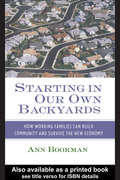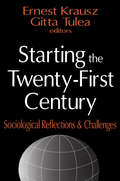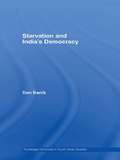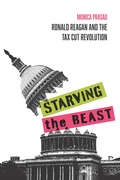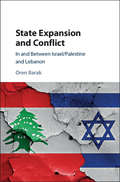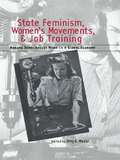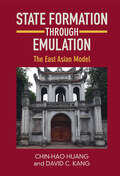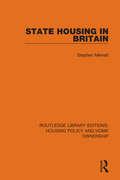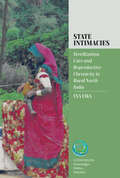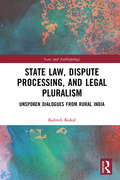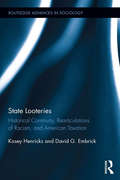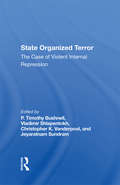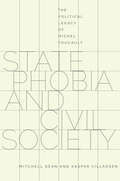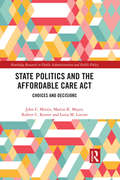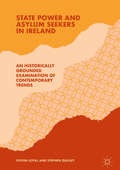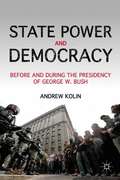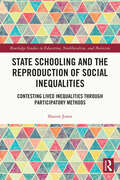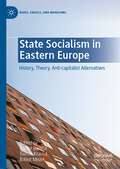- Table View
- List View
Start-up Wolf: The Shenzhen Model of High-Tech Entrepreneurship
by Olivia Yijian LiuTransnational entrepreneurs with technological know-how have been promoted by the Chinese state and academic literature as a central force for regional development of industrial competitiveness. But what motivates them, and what do they experience and aspire to when building a start-up in China? This book answers these questions by examining how socially privileged entrepreneurial talents adopt and champion the "wolf culture" – a fast-paced, competitive, and aspirational work culture – that has become prevalent since China's mass promotion of entrepreneurship and innovation.Based on extensive field research, including participant observation and interviews in Shenzhen's high-tech industry, this book challenges the popular notion of entrepreneurship as entirely self-initiated and passion-driven. Outlining the concrete instruments of governance of the local state, the author argues that transnational talent from elite schools or elite professions is often "entrepreneured" in China. Moreover, she argues that the different standards of selection of entrepreneurial talents by state and market actors create localised precarious conditions for them. This book offers fascinating insights into the contradictions inherent in the Chinese model of entrepreneurship.Start-up Wolf will appeal to scholars and students of China studies, the anthropology of entrepreneurship, science and technology studies, and economic geography, as well as business practitioners interested in innovation and high-tech start-ups.The Open Access version of this book, available at http://www.taylorfrancis.com, has been made available under a Creative Commons Attribution-Non Commercial-No Derivatives (CC-BY-NC-ND) 4.0 license.
Starting From Zero: Reconstructing Downtown New York
by Michael SorkinArchitect and social critic Michael Sorkin develops his own vision of the future lower Manhattan through a series of chronologically organized essays illustrated with full-color images of his own plans. Mixing his inimitable brand of social criticism with more personal reflections, Starting From Zero offers a striving challenge to the Ground Zero redevelopment plan recently chosen by New York's establishment insiders.
Starting Lean from Scratch: A Senior Leader’s Guide to Beginning and Steering an Organizational Culture Change for Continuous Improvement
by Brent Donald TimmermanWhat if the problem is you? For organizations just preparing to begin a continuous-improvement (CI) journey, the behaviors of the leadership must transform dramatically for the Lean toolkit to succeed. Many organizations invest in training colleagues about the power of the tools but fail to address the behavior and mindset of the leadership. Unfortunately, misaligned leadership behaviors will counteract any culture change that is attempted simply by pushing the use of Lean tools. This book outlines a comprehensive set of leadership principles that must be understood and modelled by the leadership before the CI Journey can effectively begin. This book organizes these leadership principles into a framework of a conceptual model called the "Three Spaces of Lean Transformation." The model suggests that these spaces of Trust, Change, and Continuous Improvement must be consciously shaped, developed, and maintained by the organizational leadership if a continuous improvement culture change succeeds. This book organizes a set of leadership principles -- that supports the culture change -- into each of these three spaces. The book is written in the first-person narrative and maintains a mentoring format. This book is for professionals at the very beginning of an intimidating Lean journey and with very little background or formal Lean training. Although these leadership principles are framed in the approach of being necessary to support an innovation culture change, the principles are, in fact, those necessary to support effective employee engagement. In addition, this set of leadership principles, if modeled consistently by the leaders, will create an organizational culture that will attract and retain great employees. These principles form the strong leadership foundation that must be established in organizations where, previously, many of the leadership behaviors were contrary to what is required by a "Lean" organization. The proper adoption of these leadership principles by an organization will support the long-term success of the Lean journey, and that this will enable a lasting, not a temporary, change to a continuous improvement culture.
Starting Points: Intellectual and Institutional Foundations of Organization Theory (Elements in Organization Theory)
by Bob Hinings Renate MeyerThis Element reviews the first 120 years of organization theory, examining its development from the sociology of organizations and management theory. It is initially organized around two streams of thought. The first is found in political economy and the sociology of organizations, with an emphasis on understanding the new organizations that arose in the late nineteenth and early twentieth centuries. The second derives from practitioner–scholars, whose aim was to provide theories and approaches to managing these new organizations. The Element then shows how each of the streams of understanding and managing came together to produce organization theory. In doing this, it also describes how the institutional frameworks in academic associations, academic centres and journals came out of these approaches and how they strengthened the development of organization theory.
Starting Statistics: A Short, Clear Guide
by Neil BurdessStatistics: A Short, Clear Guide is an accessible, humorous and easy introduction to statistics for social science students. In this refreshing book, experienced author and academic Neil Burdess shows that statistics are not the result of some mysterious "black magic", but rather the result of some very basic arithmetic. Getting rid of confusing x′s and y′s, he shows that it′s the intellectual questions that come before and after the calculations that are important: (i) What are the best statistics to use with your data? and (ii) What do the calculated statistics tell you? Statistics: A Short, Clear Guide aims to help students make sense of the logic of statistics and to decide how best to use statistics to analyse their own data. What′s more, it is not reliant on students having access to any particular kind of statistical software package. This is a very useful book for any student in the social sciences doing a statistics course or needing to do statistics for themselves for the first time.
Starting in Our Own Backyards: How Working Families Can Build Community and Survive the New Economy
by Ann BookmanContaining interviews with more than 100 middle-class working parents in the Boston area, Bookman vividly illustrates the inherent conflicts faced by today's two-working-parent families and the often unfortunate consequences for the community. In an important departure from the ongoing debate, she offers a new paradigm for the relationship between paid and unpaid work that could invigorate both family life and the quality of civil society.
Starting the Twenty-first Century: Sociological Reflections and Challenges
by Ernest Krausz Gitta TuleaJrgen Habermas, speaking of postmodern society, remarked that extension of the means of communication not only allows a wide range of information, but it also encourages permanent connections between different peoples, cultures, and social discourses. It thus facilitates better general understanding, a clarifying of real or apparent contradictions. But this process becomes truly positive only when it is performed between equal members. Globalization of information does not minimize the possibility of conflict or terrorism, if fundamental social problems are not resolved or at least approached in an active way.This volume examines the major upheavals of the twentieth century and views within the framework of these events and challenges implications for the future. "Values and Cultural Changes in the Postmodern World," by Zygmunt Bauman explores the changing meaning of space in the globalizing environment; S.N. Eisenstadt analyzes the destructive components of modernity; and Irving Louis Horowitz draws attention to the classical values of the common universal culture. "Social Development and Policies in Contemporary Society," by Michael M. Cernea, examines the importance of the applied and policy-orientated research, especially in the developing countries, and David Marsland stresses the positive role of sociology in pointing to the possibilities of improving healthcare in modern society. "Societies in Transition-Eastern Europe," emphasizes transitions that have occurred in Eastern Europe. Rozalina Rjyvkina and Leonid Kosals provide an incisive study of the situation in Russia, while Jerzy J. Wiatr presents a comparative analysis of postcommunist societies, with special reference to Poland. "The Jewish World: Pre- and Post-Holocaust," by Regina Azria, discusses the identity problems in the Diaspora confronting modernity; Eva Etzioni-Halevi considers the newly developed Israeli society from the point of view of the exercise and distribution of power; and a most interesting contribution by Annette Wieviorka concerns the material and spiritual effects of the Holocaust on the Jews of France.Social historians and students of Judaica, as well as a general public interested in cultural pluralism will find this well-developed volume essential reading.
Starting, Managing and Promoting the Small Library
by Robert BerkA guide to the establishment of the library which covers materials acquisition, the organization and usage of the library's collection to provide a variety of services and the use of automation. This book aims to instruct the librarian on managing the small library effectively.
Starvation and India's Democracy (Routledge Advances in South Asian Studies)
by Dan BanikThis book analyzes India’s impressive efforts in responding to sensational and easily visible disasters in contrast to the ‘silent emergency’ of drought-induced under nutrition and starvation deaths. Building on Amartya Sen’s famous claim that no famine has ever occurred in a democratic country, it re-examines the relationship between democracy, public action and famine prevention. Drawing on both quantitative and qualitative data in India at national, state and local levels as well as in-depth field visits to two states on India’s east coast, Orissa and West Bengal, the author analyzes the following issues: the interaction between specific institutions in India and their accountability to the public the role of the media in highlighting problems of extreme poverty and destitution and the effectiveness of political and administrative responses to such reports the extent to which tribal groups are vulnerable to starvation and famine, and an analysis of whether starvation deaths in drought-prone Kalahandi district in Orissa are unique in India the impact of two major nutrition programmes, the Public Distribution System (PDS) and the Integrated Child Development Services (ICDS), in reducing the incidence, duration and impact of starvation deaths. Starvation and India’s Democracy will be of interest to researchers in economics, political science, philosophy, development studies and South Asian studies.
Starving the Beast: Ronald Reagan and the Tax Cut Revolution
by Monica PrasadSince the Reagan Revolution of the early 1980s, Republicans have consistently championed tax cuts for individuals and businesses, regardless of whether the economy is booming or in recession or whether the federal budget is in surplus or deficit. In Starving the Beast, sociologist Monica Prasad uncovers the origins of the GOP’s relentless focus on tax cuts and shows how this is a uniquely American phenomenon. Drawing on never-before seen archival documents, Prasad traces the history of the 1981 tax cut—the famous “supply side” tax cut, which became the cornerstone for the next several decades of Republican domestic economic policy. She demonstrates that the main impetus behind this tax cut was not business group pressure, racial animus, or a belief that tax cuts would pay for themselves. Rather, the tax cut emerged because Republicans believed that following World War II, Democrats had created an extremely durable power structure based on offering government programs to Americans, through which they were able to unify an otherwise fractious coalition of farmers, workers, and African Americans and retain control of Congress for four decades. Republicans were reduced to lecturing about balanced budgets, an issue that did not win them many elections. The Republican party began to see tax cuts as an opportunity to alter these basic building blocks of American power. If Democratic power was built out of government programs, Republicans found a new power source in offering tax cuts. Once it became clear that the resulting deficits could be financed by foreign capital, this program reoriented the Republican Party, transforming it from the party of fiscal rectitude into a party whose main domestic policy goal is reducing taxes. With one party promoting government programs to appeal to voters and the other party promoting tax cuts to appeal to voters, and neither party able to generate electoral coalitions around addressing more pressing political and economic problems, this history reveals problems at the heart of contemporary American democracy itself. Prasad suggests some ways forward. Since the end of World War II, many European nations have combined strong social protections with policies to stimulate economic growth such as lower taxes on capital and less regulation on businesses than in the U.S. Starving the Beast suggests that taking inspiration from this model of progressive policies embedded in market-promoting political economy could serve to build an American economy that works better for all.
State Expansion and Conflict: In and between Israel/Palestine and Lebanon
by Oren BarakLebanon and Israel/Palestine are two political entities that expanded in 1920 and 1967 respectively, and became divided societies characterized by periods of stability and conflict. This book provides the first detailed comparison between the two states and also explores the effects of their expansion on their changing relations. It looks first at how both expanded states attempted to cope with their predicaments, focusing on the relationship between state, community and security, before moving on to analyze the de-stabilizing effects of expansion on Israeli-Lebanese relations. The book draws on previously unpublished official documents, memoirs, media resources and films produced in Lebanon and Israel/Palestine, in addition to existing works on the two states and the Middle East. Bridging the gap between comparative politics and international relations, it will interest students of Lebanon and Israel/Palestine, the Middle East, and conflict and peace.
State Feminism, Women's Movements, and Job Training: Making Democracies Work in the Global Economy (Women in Politics in Democratic States)
by Amy G. MazurDrawing from the work of internationally renowned scholars from the Research Network on Gender, Politics and the State (RNGS), this study offers in-depth analysis of the relationship between state feminism, women's movements and public policy and places them within a comparative theoretical framework. Spain, France, Italy, Germany, Finland, Austria, Belgium, Canada, and the U.S. are all discussed individually.
State Food Crimes
by Howard-Hassmann Rhoda E.Some states deny their own citizens one of the most fundamental human rights: the right to food. Rhoda E. Howard-Hassmann, a leading scholar of human rights, discusses state food crimes, demonstrating how governments have introduced policies that cause malnutrition or starvation among their citizens and others for whom they are responsible. The book introduces the right to food and discusses historical cases (communist famines in Ukraine, China and Cambodia, and neglect of starvation by democratic states in Ireland, Germany and Canada). It then moves to a detailed discussion of four contemporary cases: starvation in North Korea, and malnutrition in Zimbabwe, Venezuela, and the West Bank and Gaza. These cases are then used to analyse international human rights law, sanctions and food aid, and civil and political rights as they pertain to the right to food. The book concludes by considering the need for a new international treaty on the right to food.
State Formation through Emulation: The East Asian Model
by David C. Kang Chin-Hao HuangNeither war nor preparations for war were the cause or effect of state formation in East Asia. Instead, emulation of China—the hegemon with a civilizational influence—drove the rapid formation of centralized, bureaucratically administered, territorial governments in Korea, Japan, and Vietnam. Furthermore, these countries engaged in state-building not to engage in conflict or to suppress revolt. In fact, war was relatively rare and there was no balance of power system with regular existential threats—the longevity of the East Asian dynasties is evidence of both the peacefulness of their neighborhood and their internal stability. We challenge the assumption that the European experience with war and state-making was universal. More importantly, we broaden the scope of state formation in East Asia beyond the study of China itself and show how countries in the region interacted and learned from each other and China to develop strong capacities and stable borders.
State Housing in Britain
by Stephen MerrettOriginally published in 1979, this book was the first to provide a comprehensive political-economic analysis of the historical origins and 20th Century experience of state housing in the UK. The first part describes the growth of municipal housebuilding in the context of slum clearance before 1914 and the cycle of boom and slump between the wars. Part 2 covers 1945- 1980 with chapters on : site acquisition and residential densities; the housebuilding industry and its standards; the balance between rehabilitation and redevelopment and the rise and fall of the high-rise flat. Sources and costs of capital finance and the management of the stock of council dwellings is also discussed. The final part reviews the development of state housing policy since the War, within a broad political and macro-economic context.
State Intimacies: Sterilization, Care and Reproductive Chronicity in Rural North India (Lifeworlds: Knowledges, Politics, Histories #4)
by Eva FiksThe public healthcare system in rural India is chronically under-resourced. It embodies and often perpetuates the wider politics of the Indian state towards its rural communities with provisions of care that are deeply entangled with violence and disgust. For rural women, such care deepens reproductive chronicity while providing temporary relief. Grounded in women’s everyday realities and experiences in sterilization camps and other healthcare settings in rural Rajasthan, State Intimacies examines the mundane workings, ambiguities and fragilities of care in post-colonial rural North India.
State Law, Dispute Processing And Legal Pluralism: Unspoken Dialogues From Rural India (Law and Anthropology)
by Kalindi KokalThis book presents an ethnography of dispute processing by non-state forums and actors in rural India. As such it sheds light on a much neglected and contested topic. Arising in the context of recent legal and political debates that question the legitimacy of non-state actors engaged in dispute processing, the book explores the nature, form, and functioning of such forums and actors in two locations in rural India. Focusing on a fishermen’s community belonging to the caste of Hindu Machimār Koḷīs in coastal Maharashtra and an agrarian community in Uttarakhand with members from the Pandit, Thakur, Bhotiā, and Harijan caste groups, this study shows the manner in which non-state forums and actors engage with state law and its regulatory systems.
State Looteries: Historical Continuity, Rearticulations of Racism, and American Taxation (Routledge Advances in Sociology)
by David G. Embrick Kasey HenricksFifty years ago, familiar images of the lottery would have been strange, as no state lottery existed then. Few researchers have uncovered the obscure role lotteries play in the changing composition of American taxation. Even less is known about what role race plays in this process. More than simply taxing those on the social margins, the emergence of state lotteries in contemporary American history represents something much more fundamental about state fiscal policy. This book not only uncovers the underlying racial factors that contextualize lottery proliferation in the U.S., but also reveals the racial consequences that lotteries have in terms of redistributing tax liability.
State Organized Terror: The Case Of Violent Internal Repression (Series On State Violence, State Terrorism, And Human Rights)
by Vladimir Shlapentokh P. Timothy Bushnell Christopher Vanderpool Jeyaratnam SundramThis book, an outcome of an international conference entitled "State Organized Terror: The Case of Violent Internal Repression", addresses the antecedent structural factors conducive to state organized terror and provides insights into the political and social psychology of state terror.
State Phobia and Civil Society
by Mitchell Dean Kaspar VilladsenState Phobia draws extensively upon the work of Michel Foucault to argue for the necessity of the concept of the state in political and social analysis. In so doing, it takes on not only the dominant view in the human sciences that the concept of the state is outmoded, but also the large interpretative literature on Foucault, which claims that he displaces the state for a de-centered analytics of power. Understanding Foucault means understanding all his interlocutors--whether Marxists, Maoists, neoliberals, or social democrats. It requires turning to Foucault's colleagues, including Deleuze and Guattari, François Ewald, and Blandine Kreigel, in relation to whom he carved out a position. And it entails an examination of his legacy in Hardt and Negri, the theorists of Empire, or in Nikolas Rose, the influential English sociologist. Foucault's own view is highly ambiguous: he claims to be concerned with the exercise of political sovereignty, yet his work cannot make visible the concept of the state. Moving beyond Foucault, the authors outline new ways of conceiving the state's role in establishing social order and in mediating between an inequality-producing capitalist economy and the juridical equality and political rights of individuals. Arguing that states and their cooperation remain of vital importance to resolving contemporary crises, they demonstrate the interdependence of state and civil society and the necessity of social forms of governance.
State Politics and the Affordable Care Act: Choices and Decisions (Routledge Research in Public Administration and Public Policy)
by John C. Morris Martin K. Mayer Robert C. Kenter Luisa M. LuceroAfter a great deal of discussion and debate across all levels of government, President Obama signed the Affordable Care Act (ACA) into law in March 2010. Since President Trump's election into office, the ACA has stayed in the headlines. Trump has continued to call for the replacement and repeal of the ACA, and several efforts have spawned in both the House and the Senate to accomplish this goal. Unlike welfare reform, which was generally embraced by all states, the ACA has proven very divisive in some states, with some states actively seeking to block implementation. Alternative solutions continue to prove elusive. To better understand the major factors driving decision-making process and state-level dynamics influencing state support or opposition of the ACA, this book examines the initial implementation through established support and opposition factors across four states: Alabama, Michigan, California, and New Hampshire. The choices made by states are a direct consequence of long-term forces, and the choices made at the national level. State Politics and the Affordable Care Act will be of interest to scholars researching in public administration, policy formulation and implementation, and policy analysis.
State Power and Asylum Seekers in Ireland: An Historically Grounded Examination of Contemporary Trends
by Steven Loyal Stephen QuilleyThis book aims to account for the reception, treatment and sometimes, eventual deportation, of asylum seekers in Ireland, by analysing how they are framed and dealt with by the Irish state. Both historically and theoretically grounded, it will discuss contemporary immigration policies and issues in light of the overall social, historical, and economic development of Irish society and state immigration policy. State Power and Asylum Seekers in Ireland will be of interest to scholars and students in the fields of historical sociology, sociological theory and social policy, with a focus on discourses of patterns of European migration, the changing role and function of the state and its policies, and the psycho-social experience of asylum seekers.
State Power and Democracy
by Andrew KolinState Power and Democracy is the first book to show that the Bush police state didn't commence when Bush was inaugurated. It proves, instead, that the seeds of an American police state can be traced all the way back to the founding of the republic.
State Schooling and the Reproduction of Social Inequalities: Contesting Lived Inequalities through Participatory Methods (Routledge Studies in Education, Neoliberalism, and Marxism)
by Sharon JonesThis book critically explores the role of state schooling in the reproduction of social class inequalities in the United Kingdom. By uniquely combining critical ethnographic methods with participatory and visual research, it foregrounds the experiences and recollections of working-class adults in relation to their past schooling. Drawing upon her own lived experiences, Jones theorises the experiences of her participants using an analysis of Marxist, Bordieuan, and Freirean frameworks to uncover relations of power and illustrate how schooling has reduced individual agency and sustained lived inequalities. By creating space for a Visual Intervention within Critical Ethnography (VICE) alongside her analysis of class and society, Jones successfully illuminates that working class struggles are not permanent, and that agency can be activated. The book also addresses an important need by centering research from the lived educational experiences of the working-class, and in particular, working-class adults. Making a unique theoretical and methodological contribution using an innovative combined methodology approach, the text ultimately highlights the potential of empowering disadvantaged individuals by raising critical consciousness. Though it is focused on the experiences of adults, this book has important understandings for all sectors of education and will be of interest to academics, researchers, and students interested in the sociology of education, research methods in education, social inequality, social class, and education politics.
State Socialism in Eastern Europe: History, Theory, Anti-capitalist Alternatives (Marx, Engels, and Marxisms)
by Eszter Bartha Tamás Krausz Bálint MezeiThis volume brings together a diverse set of scholars to address the long theoretical, conceptual and political debate on the interpretation of “actually existing” socialism in the Soviet Union and Eastern Europe. While the major paradigms – totalitarianism, neo-totalitarianism, revisionism, post-revisionism, modernization, and the world-system analysis – are well known in the Western (English-language) literature, the concept of state socialism, which has strong theoretical roots in Hungary (going back to the works of György Lukács and István Mészáros) received less international attention. This book contributes to a productive discussion about viable alternatives to capitalism by introducing and theoretically elaborating on the concept and practice of state socialism, highlighting the historical significance of Hungary’s experiment with the “new economic mechanism” of 1968. It generates a common point of reference for various generations of anti-systemic thinkers, scholars, and activists to move beyond Cold War simplifications and ideological divides, and contributes to the discussion about anti-capitalist alternatives, which are relevant today for the global left. The chapter “Dance Around a ‘Sacred Cow’: Women’s Night Work and the Gender Politics of the Mass Worker in State-Socialist Hungary and Internationally” is available open access under a Creative Commons Attribution-NonCommercial- NoDerivatives 4.0 International License via link.springer.com.
